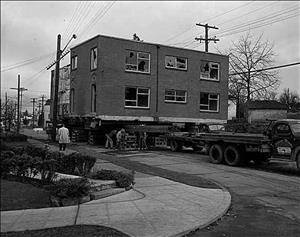On April 1, 1957, the Washington State Highway Department establishes a special office charged with property acquisition within the established right-of-way of the Seattle Freeway, now (2005) the Seattle portion of Interstate 5. Along a route some 20 miles long that cut through the city, some 4,500 parcels of land, most improved with homes, apartment buildings, and businesses, are slated for acquisition and property clearing.
How It Was Done
The state legislature authorized the sale of $75,000,000 in bonds, redeemable from federal highway funds, that were to pay 90 percent of the cost of freeway construction. This bond measure expedited the process of property acquisition since it pushed federal red tape one step further away from homeowners and gave the state a bankroll with which to cash out homeowners.
Washington State Highway Department agents visited each home within the right-of-way, contacting property owners and drawing up initial sales contracts. Washington state law guaranteed property owners fair market value for their land, which was appraised by two impartial appraisers. Most homeowners accepted the Highway Department agent's offer based upon the two appraisals, although it was possible for a homeowner to hire a third appraiser and appeal the state's offer.
Only about 10 percent of the parcels acquired were taken via condemnation proceedings. These were necessary in cases in which the state and the property owner could not agree upon a fair price. After the contract was signed the former homeowner had 90 days in which to vacate the house. Sometimes this time was extended for months or even years to suit construction schedules.
From Home to Nuisance Building
According to the newsletter published by the department, the "Right-of-way purchases are made solely for the purpose of obtaining ground area upon which to build the Freeway. Buildings that are acquired in the process are a nuisance. They must be removed either by selling through the competitive bidding procedure, or they must be demolished" (Seattle Freeway News).
Right-of-way clearing began at both ends of the future Ship Canal Bridge, in the University District and in Eastlake, and moved along the right-of-way in both directions. Daylong auctions were scheduled to allow the state to divest itself of structures. People who bid on these houses planned either to move them to another location or to strip them for salvage.
Eventually, route-clearing auctions and houses scooped off their foundations and strapped to flatbed trucks became a commonplace Seattle sight. The scarcity of available lots in North Seattle upon which a house could be re-sited made some people hesitate to bid. Ideally a house should be moved within two miles of its original location. To move it farther increased both inconvenience and expense.
Many houses were loaded onto barges at Lake Union and towed to locations throughout the Puget Sound, some even as far north as the Fraser River in British Columbia. The utility lines on 5th Avenue NE were raised for the duration of freeway construction in order to permit houses on flatbeds to pass down toward Lake Union.
Theft and Destruction
Many houses were vandalized between the time they were vacated and the time they were auctioned, or between auction and salvage/removal. Some salvagers found that valuable mahogany paneling, rockeries, floor-joists, window-sills, hot water tanks, ship-lap, door locks, light fixtures, and anything else that could be carried away had already been carried away by thieves.
Small houses on wide streets were more easily loaded onto flatbeds and transported. These houses were more valuable at auction than large houses on small streets. When older homes were relocated they had to be brought up to code, a sometimes costly undertaking. The cost incurred in moving a house was often equal to its price at auction.
Sometimes clearing the right-of-way took years after the structures had been purchased. These homes were sometimes rented out until the clearing in that area was scheduled to begin. Houses that were not rented were nailed shut and boarded up in order to minimize looting and vandalism.
The 20.5 miles of freeway route were cleared of structures, and the roadway graded. As the freeway rose, a concrete scar built up across the neighborhoods. Seattle art gallery owner Zoe Dusanne (1884-1972) was quoted in the March 23, 1958, issue of Time magazine in an article describing freeway right-of-way takes around the nation: "The uprooted may agree with Seattle art dealer Zoe Dusanne, whose home and gallery overlooking Lake Union will soon disappear before the Everett-Seattle-Tacoma freeway. Says she: 'I'm a great fan of progress. But what a pity progress has to cost so much'"(Time).

